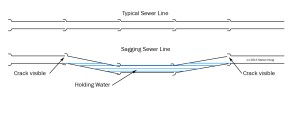Home Buying 101: Sewer Line Inspections
Figure out your needs
Monthly cost of owning a home
Ideal Neighborhood
Financing Your Purchase
The FHA Mortgage
The Conventional Mortgage
The Adjustable Rate Mortgage
Department Of Veterans Affairs Mortgage
Pre-Qualified vs Pre-ApprovalPhase 2: Looking
Looking at homes
Types of homes
Single Family Homes
Town Homes
Condominium
Twin Homes
Multi-Family Homes
Types of sellers
Traditional
Short Sale
Foreclosed
Researching A Home’s Public Information
Phase 3: Buying
Making an offer that counts
The Purchase Agreement
Buyer Letter to Seller
Inspections: Why get one?
Radon Testing
Fireplace Chimney Inspection
Mechanicals
Phase 4: Closing
Closing Costs Explained
Title Work
Appraisals
Underwriting
Utility Bills
Preparing for the Closing
The Closing
I recently had 2 buyers both perform a sewer line inspection, one in South Minneapolis and one in St. Louis Park. They both happen to use the same company, but both had completely different results.
Why do a sewer line inspection
Sewer lines can be constructed using very different methods. The most common ones are a solid pipe, usually PVC, and individual clay pipe sections, each being about 2-3 feet long. Each clay tile section fits into the prior section, and the joint between the tiles can become loose over time. When it becomes loose, tree and plant roots can start to grow in the joints, and these tree roots can get so thick, they will eventually clog the sewer line. This results in the dreaded sewer line backup where raw sewage is coming up from the basement floor drain or the house drains are draining slowly.
The results of the inspections
 The sewer line inspection in St. Louis Park revealed that the sewer line had been recently re-lined and was in very good condition except for a tiny bit of roots at the very end of the line where it connects to the sewer main. This was very good news for the buyers as they wouldn’t have to worry too much about the sewer line for quite a while.
The sewer line inspection in St. Louis Park revealed that the sewer line had been recently re-lined and was in very good condition except for a tiny bit of roots at the very end of the line where it connects to the sewer main. This was very good news for the buyers as they wouldn’t have to worry too much about the sewer line for quite a while.
The second inspection in South Minneapolis revealed a section of the pipe that was sagging. This section had come down so far, you could see the cracks in between the joints, and it was holding water (sewage). If you take a look at my crude drawing, you’ll see what I mean. This is a sewer line that is showing signs of failure. It may still function correctly for now, but how long until one end gives way and the sewage has nowhere to go?
This is easily a $6,000-$8,000 problem. A sewer line company would have to dig up the yard, install new piping, and connect it to the city sewer line. This is not an easy task, and most people wouldn’t even consider tackling it themselves. In the end, we backed out of this house due to the seller not wanting to lower the price of the house based on the condition of the sewer line. The funny thing is that a week later, the front yard was dug up and the seller was installing a new sewer line. When we found this out, we submitted another offer. It was accepted, and the buyers ended up with the home and a new sewer line. This $180 inspection saved the buyers $6000, plus we also lowered the purchase price by another $2000.
